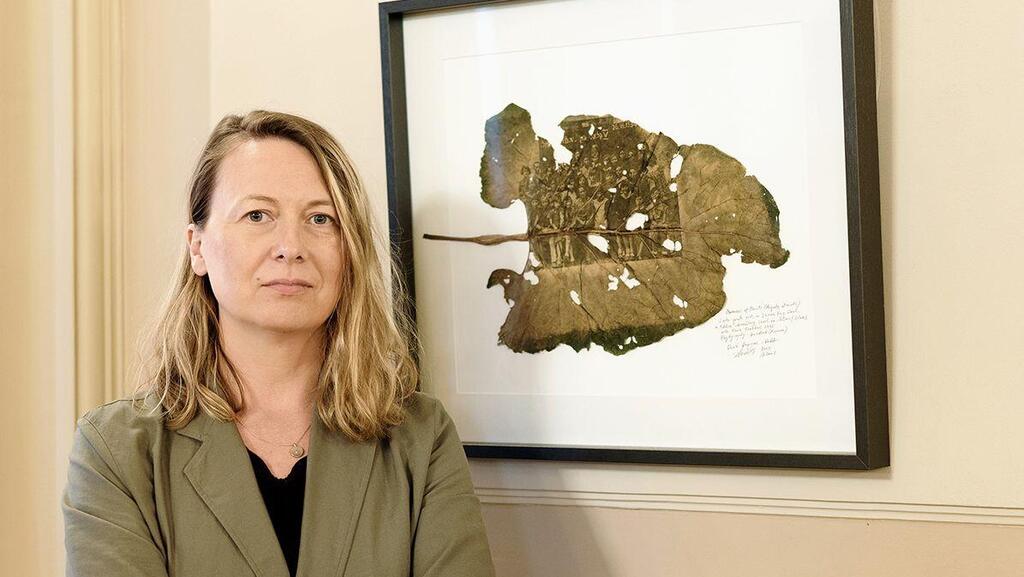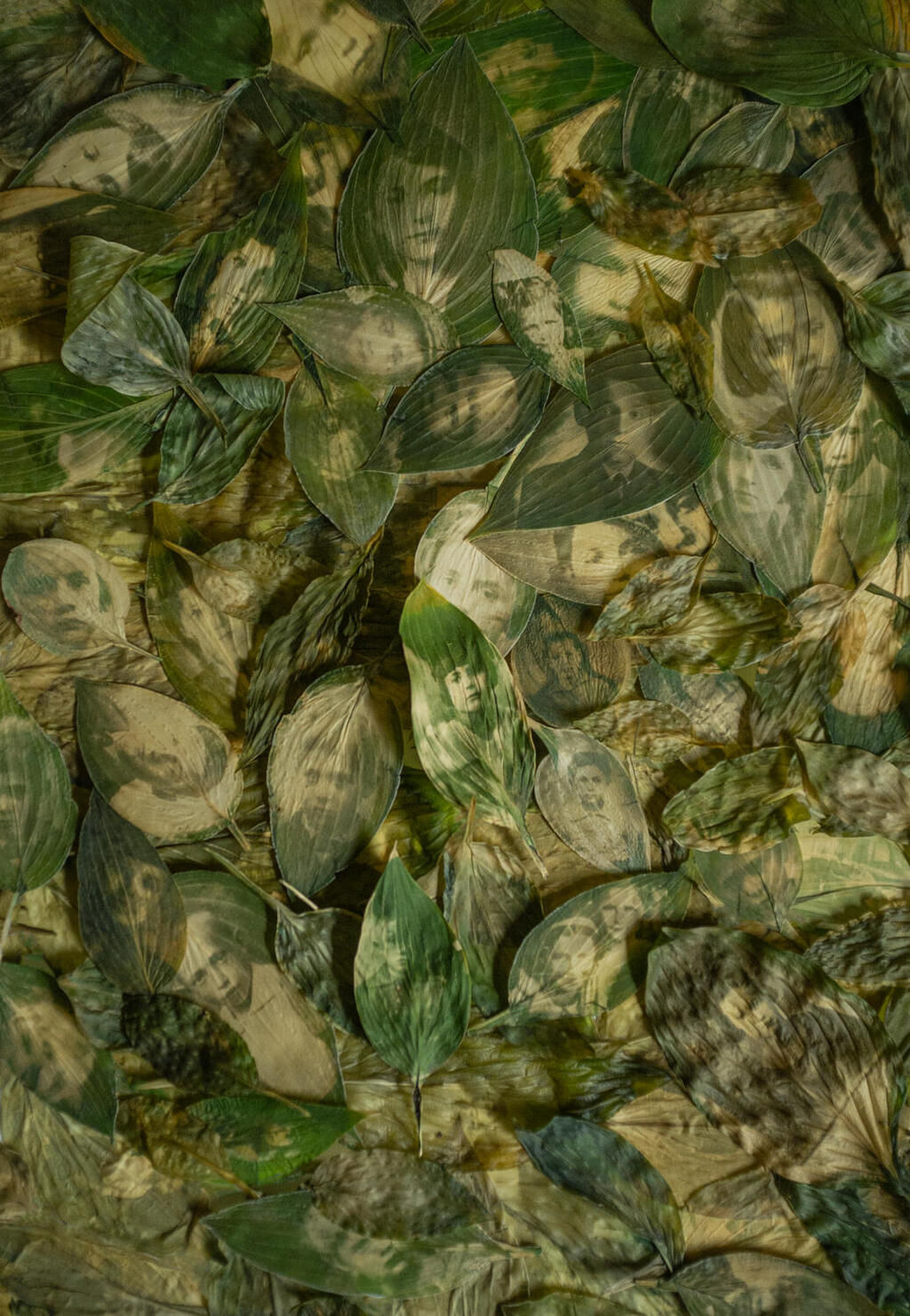Getting your Trinity Audio player ready...
"Lithuanians in Vilnius remember that, after the destruction of the ghetto, numerous photographs were scattered across the city's streets like fallen leaves. These photos were collected and eventually donated to the archive," says Lithuanian artist and photographer Dovilė Dagienė.
This memory sparked the inspiration for her exhibition, "Memories of Plants." The exhibition features works where Dagienė has integrated old photographs of children from the Vilnius Ghetto onto leaves collected from present-day Vilnius. Through this, she connects the images of Jewish children with the natural vegetation of their surroundings.
The exhibition is currently hosted at the Ghetto Fighters' House Museum in the Western Galilee until June 2025, curated by Lilach Efraim. The photographs used by Dagienė are preserved in the Vilna Gaon Jewish Museum's archive of Jewish history. For several years, Dagienė has explored the theme of memory by photographing abandoned synagogues in Lithuania, where she noticed plants and lichens growing on the wooden structures.
Dagienė explains that her choice to explore the link between botany and the tragic history of Jews in Vilnius during the Holocaust is not coincidental. "One day, two university professors came up to my husband and asked - 'do you know that your grandfather (a famous Lithuanian botanist) saved his colleague Jakub Mowszowicz (also a botanist) from the Vilnius ghetto during the war?' We didn't know this story. Most likely because the grandfather did not consider his help to a fellow botanist to be something special that should be talked about. However, I became interested in the life and fate of his colleague botanist J. Mowszowicz. Later, I even managed to find a short autobiography written by Jakub Mowszowicz himself and published in 1968, in which he tells about the terrible years he lived through, and uses the opportunity to thank his Lithuanian friends, including my husband’s grandfather," the artist said.
Jacob (Jakub) Mowszowicz was a botanist at Stefan Batory University in Vilnius. ". In 1936, he defended his thesis on the flora and plant communities of the Paneriai hills and meadows. This was the beginning of a prosperous and promising young scientist's life in Vilnius and Paneriai had not yet acquired its sad reputation," Dagienė notes. "A few years later, in September 1941, Mowszowicz and his entire extended family entered the Vilnius ghetto. All his relatives and close family were killed in Paneriai, and he, with the help of his colleagues, managed to survive."
4 View gallery


The old pictures that were embedded in the leaves
(Photo: Courtesy of Dovilė Dagienė)
She adds: "There are testimonies that J. Mowszowicz worked as a teacher in the Vilnius ghetto. He also managed to take children out of the ghetto to the Vilnius Botanical Garden several times, so that they could recover at least a little from the terrible living conditions in the ghetto. While collecting these stories, I unconsciously caught myself thinking that in human culture children are often compared to plants and flowers. We give children the image of a plant, something that grows into the future. And here is a terrible war that stops that growth."
From these plants, which symbolize life and growth, she created a kind of memorial.
Many of the photographs are unidentified. Dagienė created the 24 pieces in the exhibition using an organic photography technique called anthotypes.
"The name comes from the Greek word ánthos, meaning flower," she explains. "It is a long-discovered alternative process to organic photography that uses light-sensitive plant pigments, usually chlorophyll to produce a photographic image. One of the possible results of the anthotype technique is chlorophyll prints or, as I propose to call them – phytographies (Greek phyton - plant, grafo - I write). It is indeed a time and light sensitive print. I have discovered the technology to retain the image on a leaf for a long time, but sometimes I leave a few unprotected prints in the exhibition so that they will continue to fade in the sunlight as a reminder of how memory works."
Do we know what happened to the children in the photographs? Did any of them survive?
"People often ask this question. I'm afraid I have no good news and unfortunately, nothing comforting can be said about the fate of these children. Most of their lives ended tragically. The people of the city remember that after the liquidation of the ghetto, there were many photographs scattered on the streets of Vilnius like leaves that had fallen from the trees, which they collected and later gave to the archive. Many of these photographs are not even identified, only marked where they were found. Some of the children's names are not known."
What personally connected you to stories of the Jewish children who lived in the ghetto during the Holocaust?
"I was deeply moved by this study. While researching the archives, I remembered many sensitive stories that I found. For example in what terrible conditions living in the ghetto, hungry and cold children managed not to lose their sincerity and openness to the to the world and remained playful. They, like plants, naturally tried to adapt to all the most difficult conditions. Or their teachers, who tried to create the best possible conditions for the children and give them hope that the war will end soon. Or about those who risked their lives to save the ghetto residents. All this reminded me of a girl who grew up in the family of my husband's relatives, who managed to save her from the ghetto as a baby during the war."
4 View gallery


The exhibit in the Ghetto Fighters' House Museum
(Photo: Ghetto Fighters' House Museum)
Are you aware of the rise in antisemitism in Europe? Do you feel it?
"I could not say that in my country one could feel a generally larger wave of antisemitism, but from what I see in the media channels in the world, the prevailing atmosphere on this issue is sad. People become categorical and intolerant of others. Sometimes it seems that today the world is becoming more and more categorical and there is less and less room for tolerance and empathy."
Yigal Cohen, CEO of the Ghetto Fighters' House Museum, said: "We are excited to open this unique exhibition, which artistically presents the story of the Jewish community during the Holocaust, particularly in Lithuania. This unique exhibition is a reminder of the resilience and endurance of the Jewish community. I hope this exhibition will inspire and encourage discussion and deeper understanding of the story of Lithuanian Jews during the Holocaust, as well as highlight the need for documentation and commemoration of our history through art and other means."




